A Hybrid Framework Integrating End-to-End Deep Learning with Bayesian Inference for Maritime Navigation Risk Prediction
Abstract
1. Introduction
- Hybrid Spatio-Temporal Trajectory Prediction: This innovation combines Convolutional Neural Networks (CNN), Bidirectional Long Short-Term Memory (BiLSTM) networks, and Multi-Head Attention mechanisms to overcome the shortcomings of single-model approaches in ship trajectory forecasting. Specifically:
- (1)
- CNN layers extract localized patterns from short-term motion data (e.g., speed fluctuations or heading adjustments).
- (2)
- Multi-Head Attention dynamically weights key historical time steps, focusing on critical navigation segments.
- (3)
- BiLSTM processes sequential data bidirectionally, capturing long-range dependencies for robust predictions.
- Electronic Navigational Chart (ENC)-Aware Spatial Database: We developed a dynamic spatial query system that bridges the “sim-to-real gap” by providing real-time environmental context based on predicted trajectories. Key features include:
- (1)
- Trajectory-conditioned queries that retrieve obstacle distributions and bathymetric data (e.g., water depth) along a vessel’s path.
- (2)
- Spatial indexing (e.g., R-trees) for efficient obstacle and depth retrieval within a local radius, reducing reliance on static maps.
- (3)
- Database schema with hierarchical tables for navigational aids, bathymetric areas, and dynamic elements, ensuring consistency with shipboard data surfaces.
- This enables real-time scene awareness, supporting accurate risk evaluation in dynamic waterways.
- Bayesian Risk Prediction with Interpretable Posteriors: A Bayesian network framework quantifies collision and grounding risks transparently, Specifically:
- (1)
- Evidence integration: Combines vessel motion data (position, SOG, COG), environmental factors (obstacle distance, water depth), and external conditions (e.g., weather) into a probabilistic model.
- (2)
- Dynamic inference: Uses Variable Elimination to compute posterior probabilities in real time.
- Closed-Loop Decision Support System: This innovation closes the feedback loop from prediction to action, enabling minute-level risk warnings and proactive navigation control:
- (1)
- Integrated workflow: Links trajectory prediction, environment querying, Bayesian inference, and action suggestions in a seamless cycle with <5 s latency.
- (2)
- Actionable outputs: Maps risk probabilities to International Regulations for Preventing Collisions at Sea (COLREGs)-compliant maneuvers, such as course adjustments (θnew = θcurrent + θoptimal) or speed reductions
- (3)
- Real-time performance: Operates via sliding-window updates, maintaining system stability and responsiveness even with data anomalies.
2. Related Work
2.1. Data-Driven Deep Learning for Vessel Trajectory Prediction
2.2. Navigation Risk Prediction and Assessment
2.3. Decision-Making Under Uncertainty and POMDPs
3. Model Structure: End-to-End Ship Navigation Risk Prediction Model
3.1. Overall Framework Overview
- (1)
- Trajectory predictor—Input: AIS window of length T with {x, y, speed over ground (SOG), course over ground (COG)}; Output: next-step {x, y, SOG, COG} (+ optional uncertainty).
- (2)
- ENC perception—Input: predicted path polyline; Output: distances to static obstacles, local bathymetry, fairway width, and proximity features.
- (3)
- Bayesian risk head—Input: predictor outputs + ENC features (+ optional weather); Output: posterior P(collision)/P(grounding) and three-tier alert {Green, Yellow, Red}.
3.2. Data Processing
3.2.1. AIS Data Processing
- (1)
- Quality control. Remove records with invalid MMSI/coordinates/time order; deduplicate near-identical timestamps; drop speeds outside physically feasible bounds.
- (2)
- Anomaly screening. Detect spikes in SOG/COG and spatial outliers using simple thresholds plus a density-based check; flagged points are treated as missing and will not inform the model.
- (3)
- Uniform resampling. Rebuild each trajectory on a fixed interval (Δt), using distance-aware interpolation to preserve local kinematics; sequences are truncated/padded to a fixed window length T.
- (4)
- Navigation-mode labeling. Assign coarse modes (e.g., cruising, maneuvering, anchoring) from speed/turn-rate rules to provide optional context features.
- (1)
- quality control;
- (2)
- anomaly screening;
- (3)
- uniform resampling;
- (4)
- navigation-mode labeling.
3.2.2. Nautical Chart Data Processing and Database Construction
- (1)
- Sources are harmonized to a single CRS and Coordinated Universal Time (UTC) timestamps to avoid runtime transforms.
- (2)
- Distance/bearing are computed against the forecasted waypoints, not just the current fix, to align with lead-time evaluation.
- (3)
- Geometry fields are indexed and basic integrity checks (e.g., angle ranges, symbol sizes) are enforced to keep queries robust under noisy inputs.
3.3. Trajectory–Risk Collaborative Prediction Model
3.3.1. Trajectory Prediction Module
3.3.2. Bayesian Risk Prediction Model
3.3.3. Multi-Module Collaborative Risk Generation Mechanism
3.4. Uncertainty Propagation
4. Comprehensive Model Validation and Practical Deployment Assessment
4.1. Performance Validation
4.1.1. Training Evaluation of Trajectory Prediction Module
4.1.2. End-to-End System Functionality Assessment
4.1.3. Single-Factor Sensitivity Analysis
Vessel Speed Analysis
Obstacle Density Analysis
- (1)
- Low (2 obstacles/km2)
- (2)
- Medium (5 obstacles/km2)
- (3)
- High (10 obstacles/km2)
Water Depth Analysis
- (1)
- Shallow (near vessel draft)
- (2)
- Normal
- (3)
- Deep
4.1.4. Multi-Factor Disturbance Evaluation
4.2. Practical Deployment and Decision Support Validation
4.2.1. Decision Support Effectiveness Evaluation Experiment
4.2.2. System Robustness and Real-Time Performance Assessment
4.2.3. Cross-Domain Generalizability and Baseline Comparison
5. Discussion
5.1. Scalability and Future Technology Integration
5.2. Practical Implications
5.3. Engineering Expansion and Integration Path
5.4. Limitations/Threats to Validity
6. Conclusions and Outlook
6.1. Summary of Contributions
6.2. Outlook
Author Contributions
Funding
Data Availability Statement
Conflicts of Interest
References
- He, Z.; He, Z.; Li, S.; Yu, Y.; Liu, K. A Ship Navigation Risk Online Prediction Model Based on Informer Network Using Multi-Source Data. Ocean. Eng. 2024, 298, 117007. [Google Scholar] [CrossRef]
- Jaskólski, K. Automatic identification system (AIS) dynamic data estimation based on discrete Kalman filter (KF) algorithm. Zesz. Nauk. Akad. Mar. Wojenne 2017, 58, 71–87. [Google Scholar]
- Fossen, S.; Fossen, T.I. Extended Kalman filter design and motion prediction of ships using live automatic identification system (AIS) data. In Proceedings of the 2nd European Conference on Electrical Engineering and Computer Science, Bern, Switzerland, 20–22 December 2018; pp. 464–470. [Google Scholar]
- Zhang, X.; Liu, G.; Hu, C.; Ma, X. Wavelet analysis based hidden Markov model for large ship trajectory prediction. In Proceedings of the 38th Chinese Control Conference, Guangzhou, China, 27–30 July 2019; pp. 2913–2918. [Google Scholar]
- Niu, J.; Li, L.; Chen, C.; Sun, H.; Qiao, L. Application of weighted grey theory in analysis and prediction of maritime accidents. Navig. China 2016, 39, 63–67. [Google Scholar]
- Wen, G.; Yu, X. Grey relational analysis of accident types in fisheries vessels. J. Dalian Ocean. Univ. 2017, 32, 237–241. [Google Scholar]
- Li, H.; Huang, J.; Li, R. Application of grey prediction theory in ship machinery failure diagnosis. J. Shanghai Marit. Univ. 2017, 38, 85–89. [Google Scholar]
- Su, D.T.; Tzu, F.M.; Cheng, C.H. Investigation of oil spills from oil tankers through grey theory: Events from 1974 to 2016. Mar. Sci. Eng. 2019, 7, 373. [Google Scholar]
- Zhang, W.; Feng, X.; Goerlandt, F.; Liu, Q. Towards a convolutional neural network model for classifying regional ship collision risk levels for waterway risk analysis. Reliab. Eng. Syst. Saf. 2020, 204, 107127. [Google Scholar] [CrossRef]
- Li, K.X.; Yin, J.; Bang, H.S.; Yang, Z.; Wang, J. Bayesian network with quantitative input for maritime risk analysis. Transp. A Transp. Sci. 2014, 10, 89–118. [Google Scholar] [CrossRef]
- Zhou, H.; Zhang, S.; Peng, J.; Zhang, S.; Li, J.; Xiong, H.; Zhang, W. Informer: Beyond efficient transformer for long sequence time-series forecasting. Proc. AAAI 2021, 35, 11106–11115. [Google Scholar] [CrossRef]
- Fu, S.; Yu, Y.; Chen, J.; Xi, Y.; Zhang, M. A framework for quantitative analysis of the causation of grounding accidents in arctic shipping. Reliab. Eng. Syst. Saf. 2022, 226, 108706. [Google Scholar] [CrossRef]
- Wang, M.; Wang, Y.; Ding, J.; Yu, W. Interaction Aware and Multi-Modal Distribution for Ship Trajectory Prediction with Spatio-Temporal Crisscross Hybrid Network. Reliab. Eng. Syst. Saf. 2024, 252, 110463. [Google Scholar] [CrossRef]
- Li, W.; Henke, M.; Pundt, R.; Miller-Hooks, E. A Data-Driven Bayesian Network Methodology for Predicting Future Incident Risk in Arctic Maritime-Based Cargo Transit. Ocean. Eng. 2025, 320, 120299. [Google Scholar] [CrossRef]
- Li, H.; Xing, W.; Jiao, H.; Yuen, K.F.; Gao, R.; Li, Y.; Matthews, C.; Yang, Z. Bi-Directional Information Fusion-Driven Deep Network for Ship Trajectory Prediction in Intelligent Transportation Systems. Transp. Res. Part E Logist. Transp. Rev. 2024, 192, 103770. [Google Scholar] [CrossRef]
- Zhang, W.; Ma, X.; Zhang, Y. Research on Navigation Risk Assessment Index System of Intelligent Ships. Ocean Eng. 2025, 322, 120435. [Google Scholar] [CrossRef]
- Liu, Z.; Qi, W.; Zhou, S.; Zhang, W.; Jiang, C.; Jie, Y.; Li, C.; Guo, Y.; Guo, J. Hybrid Deep Learning Models for Ship Trajectory Prediction in Complex Scenarios Based on AIS Data. Appl. Ocean. Res. 2024, 153, 104231. [Google Scholar] [CrossRef]
- Li, P.; Wang, Y.; Yang, Z. Risk Assessment of Maritime Autonomous Surface Ships Collisions Using an FTA-FBN Model. Ocean. Eng. 2024, 309, 118444. [Google Scholar] [CrossRef]
- Zeng, X.; Gao, M.; Zhang, A.; Zhu, J.; Hu, Y.; Chen, P.; Chen, S.; Dong, T.; Zhang, S.; Shi, P. Trajectories Prediction in Multi-Ship Encounters: Utilizing Graph Convolutional Neural Networks with GRU and Self-Attention Mechanism. Comput. Electr. Eng. 2024, 120, 109679. [Google Scholar] [CrossRef]
- Bi, J.; Gao, M.; Bao, K.; Zhang, W.; Zhang, X.; Cheng, H. A CNNGRU-MHA Method for Ship Trajectory Prediction Based on Marine Fusion Data. Ocean Eng. 2024, 310, 118701. [Google Scholar] [CrossRef]
- Lee, H.-J.; Park, D.-J. Collision Evasive Action Timing for MASS Using CNN–LSTM-Based Ship Trajectory Prediction in Restricted Area. Ocean Eng. 2024, 294, 116766. [Google Scholar] [CrossRef]
- Zhang, X.; Liu, J.; Gong, P.; Chen, C.; Han, B.; Wu, Z. Trajectory Prediction of Seagoing Ships in Dynamic Traffic Scenes via a Gated Spatio-Temporal Graph Aggregation Network. Ocean Eng. 2023, 287, 115886. [Google Scholar] [CrossRef]
- Wang, S.; Li, Y.; Xing, H. A Novel Method for Ship Trajectory Prediction in Complex Scenarios Based on Spatio-Temporal Features Extraction of AIS Data. Ocean Eng. 2023, 281, 114846. [Google Scholar] [CrossRef]
- Zhang, D.; Chu, X.; Wu, W.; He, Z.; Wang, Z.; Liu, C. Model Identification of Ship Turning Maneuver and Extreme Short-Term Trajectory Prediction under the Influence of Sea Currents. Ocean Eng. 2023, 278, 114367. [Google Scholar] [CrossRef]
- Fan, H.; Jia, H.; He, X.; Lyu, J. Navigating Uncertainty: A Dynamic Bayesian Network-Based Risk Assessment Framework for Maritime Trade Routes. Reliab. Eng. Syst. Saf. 2024, 250, 110311. [Google Scholar] [CrossRef]
- Fan, H.; Wang, J.; Chang, Z.; Lyu, J.; Jia, H. Embracing Imperfect Data: A Novel Data-Driven Bayesian Network Framework for Maritime Accidents Severity Risk Assessment. Ocean Eng. 2025, 329, 121212. [Google Scholar] [CrossRef]
- Liu, R.W.; Huo, X.; Liang, M.; Wang, K. Ship Collision Risk Analysis: Modeling, Visualization and Prediction. Ocean Eng. 2022, 266, 112895. [Google Scholar] [CrossRef]
- Wang, W.; Zhao, J.; Chen, Y.; Shao, P.; Jia, P. Process Safety Enhancement in Maritime Operations: A Bayesian Network-Based Risk Assessment Framework for the RCEP Region. Process Saf. Environ. Prot. 2025, 194, 1235–1256. [Google Scholar] [CrossRef]
- Jiang, H.; Zhang, J.; Wan, C.; Zhang, M.; Soares, C.G. A Data-Driven Bayesian Network Model for Risk Influencing Factors Quantification Based on Global Maritime Accident Database. Ocean Coast. Manag. 2024, 259, 107473. [Google Scholar] [CrossRef]
- Qiao, Q.; Zhen, R.; Dong, H.; Wang, S.; Fang, Q. Identification of Key Risk Ships in Risk-Based Ship Complex Network. Ocean Eng. 2025, 327, 120969. [Google Scholar] [CrossRef]
- Gao, D.; Zhu, Y.; Yan, K.; Soares, C.G. Deep Learning–Based Framework for Regional Risk Assessment in a Multi–Ship Encounter Situation Based on the Transformer Network. Reliab. Eng. Syst. Saf. 2024, 241, 109636. [Google Scholar] [CrossRef]
- Xu, D.; Huang, Y.; Zhou, X.; Xu, H. Path Following Control for Large Inland Ships in a Restricted Waterway Using the Nonlinear Terminal Sliding Mode Method. Ocean Eng. 2023, 284, 115159. [Google Scholar] [CrossRef]
- Lin, C.; Zhen, R.; Tong, Y.; Yang, S.; Chen, S. Regional Ship Collision Risk Prediction: An Approach Based on Encoder-Decoder LSTM Neural Network Model. Ocean Eng. 2024, 296, 117019. [Google Scholar] [CrossRef]
- Chen, P.; Zhang, Z.; Huang, Y.; Dai, L.; Hu, H. Risk Assessment of Marine Accidents with Fuzzy Bayesian Networks and Causal Analysis. Ocean Coast. Manag. 2022, 228, 106323. [Google Scholar] [CrossRef]
- Munim, Z.H.; Sørli, M.A.; Kim, H.; Alon, I. Predicting Maritime Accident Risk Using Automated Machine Learning. Reliab. Eng. Syst. Saf. 2024, 248, 110148. [Google Scholar] [CrossRef]
- Yang, X.; Liu, X.; Xu, T. Research of Ship Grounding Prediction Based on Fuzzy Theory. In Proceedings of the 2011 International Conference of Information Technology, Computer Engineering and Management Sciences, Nanjing, China, 24–25 September 2011; pp. 91–94. [Google Scholar]
- Liang, C.; Zhang, X.; Watanabe, Y.; Zhao, B. Novel L+ and FO L+ Algorithms Based on ENC Data for Automatic Route Planning of Ships. Ocean Eng. 2021, 235, 109389. [Google Scholar] [CrossRef]
- Liu, T.; Xu, X.; Lei, Z.; Zhang, X.; Sha, M.; Wang, F. A Multi-Task Deep Learning Model Integrating Ship Trajectory and Collision Risk Prediction. Ocean Eng. 2023, 287, 115870. [Google Scholar] [CrossRef]
- Maidana, R.G.; Kristensen, S.D.; Utne, I.B.; Sørensen, A.J. Risk-Based Path Planning for Preventing Collisions and Groundings of Maritime Autonomous Surface Ships. Ocean Eng. 2023, 290, 116417. [Google Scholar] [CrossRef]
- Tengesdal, T.; Johansen, T.A.; Grande, T.D.; Blindheim, S. Ship Collision Avoidance and Anti Grounding Using Parallelized Cost Evaluation in Probabilistic Scenario-Based Model Predictive Control. IEEE Access 2022, 10, 111650–111664. [Google Scholar] [CrossRef]
- Kochenderfer, M.J.; Holland, J.E.; Chryssanthacopoulos, J.P. Next-generation airborne collision avoidance system. Linc. Lab. J. 2012, 19, 17–33. [Google Scholar]
- Kurniawati, H. Partially Observable Markov Decision Processes and Robotics. Annu. Rev. Control Robot. Auton. Syst. 2022, 5, 253–277. [Google Scholar]
- Kochenderfer, M.J. Decision Making Under Uncertainty: Theory and Application; MIT Press: Cambridge, MA, USA, 2015. [Google Scholar]
- Moss, R.J.; Jamgochian, A.; Fischer, J.; Corso, A.; Kochenderfer, M.J. ConstrainedZero: Chance-Constrained POMDP Planning Using Learned Probabilistic Failure Surrogates and Adaptive Safety Constraints. In Proceedings of the 33rd International Joint Conference on Artificial Intelligence (IJCAI-24), Jeju, Republic of Korea, 3–9 August 2024. [Google Scholar] [CrossRef]
- International Maritime Organization. COLREG: Convention on the International Regulations for Preventing Collisions at Sea, 1972, Consolidated Edition 2003; International Maritime Organization: London, UK, 2003. [Google Scholar]
- International Hydrographic Organization. IHO Transfer Standard for Digital Hydrographic Data (S-57), Edition 3.1.0; International Hydrographic Organization: Monaco, Principality of Monaco, 2000. [Google Scholar]
- International Hydrographic Organization. IHO S-101 Electronic Navigational Chart (ENC) Product Specification, Edition 2.0.0; International Hydrographic Organization: Monaco, Principality of Monaco, 2024. [Google Scholar]
- International Electrotechnical Commission. IEC 61174: Maritime Navigation and Radiocommunication Equipment and Systems—Electronic Chart Display and Information System (ECDIS)—Operational and Performance Requirements, Methods of Testing and Required Test Results, 4th ed.; IEC: Geneva, Switzerland, 2015; 225p. [Google Scholar]
- Kochenderfer, M.J.; Wheeler, T.A.; Wray, K.H. Algorithms for Decision Making; MIT Press: Cambridge, MA, USA, 2022. [Google Scholar]



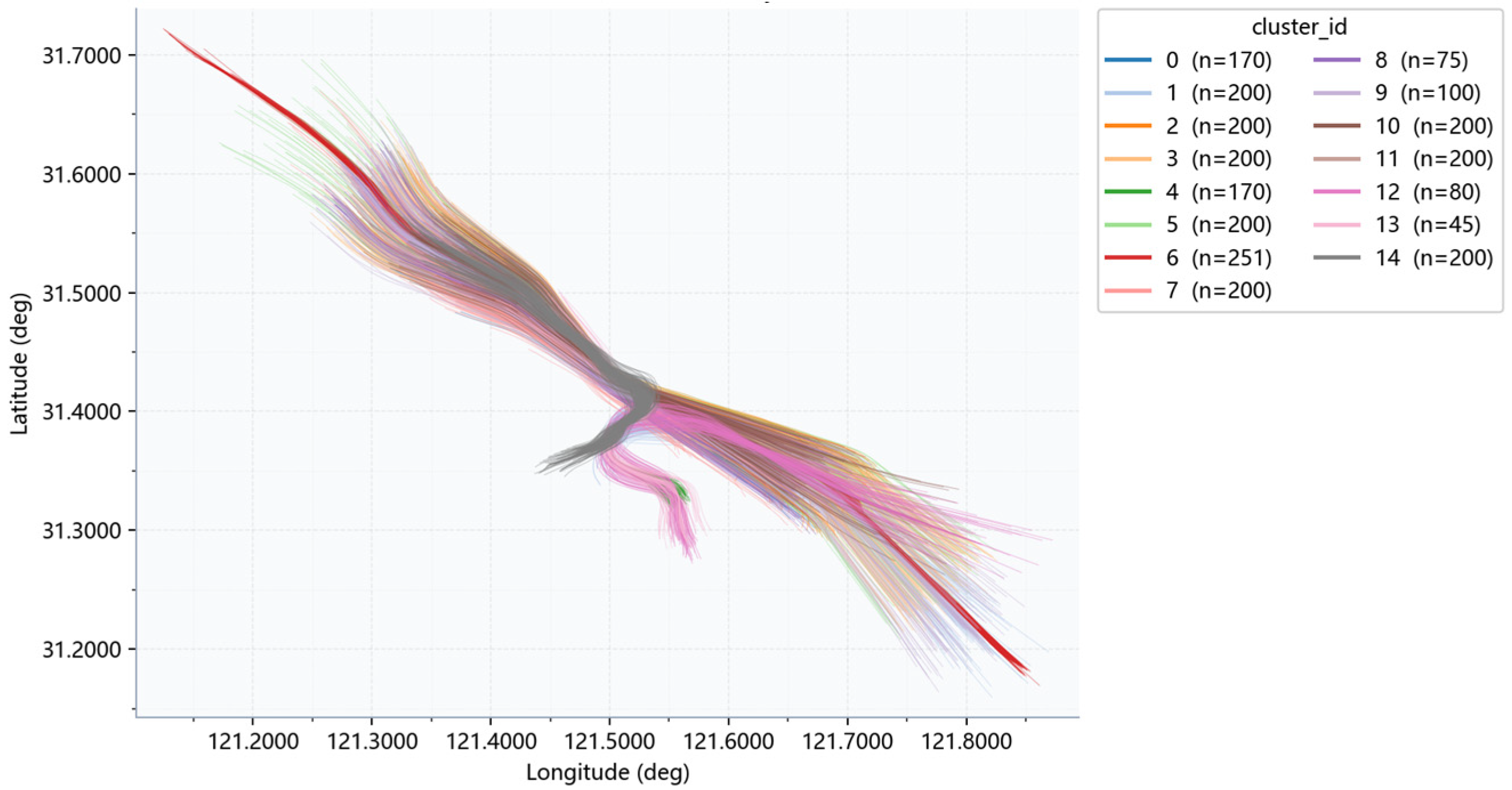




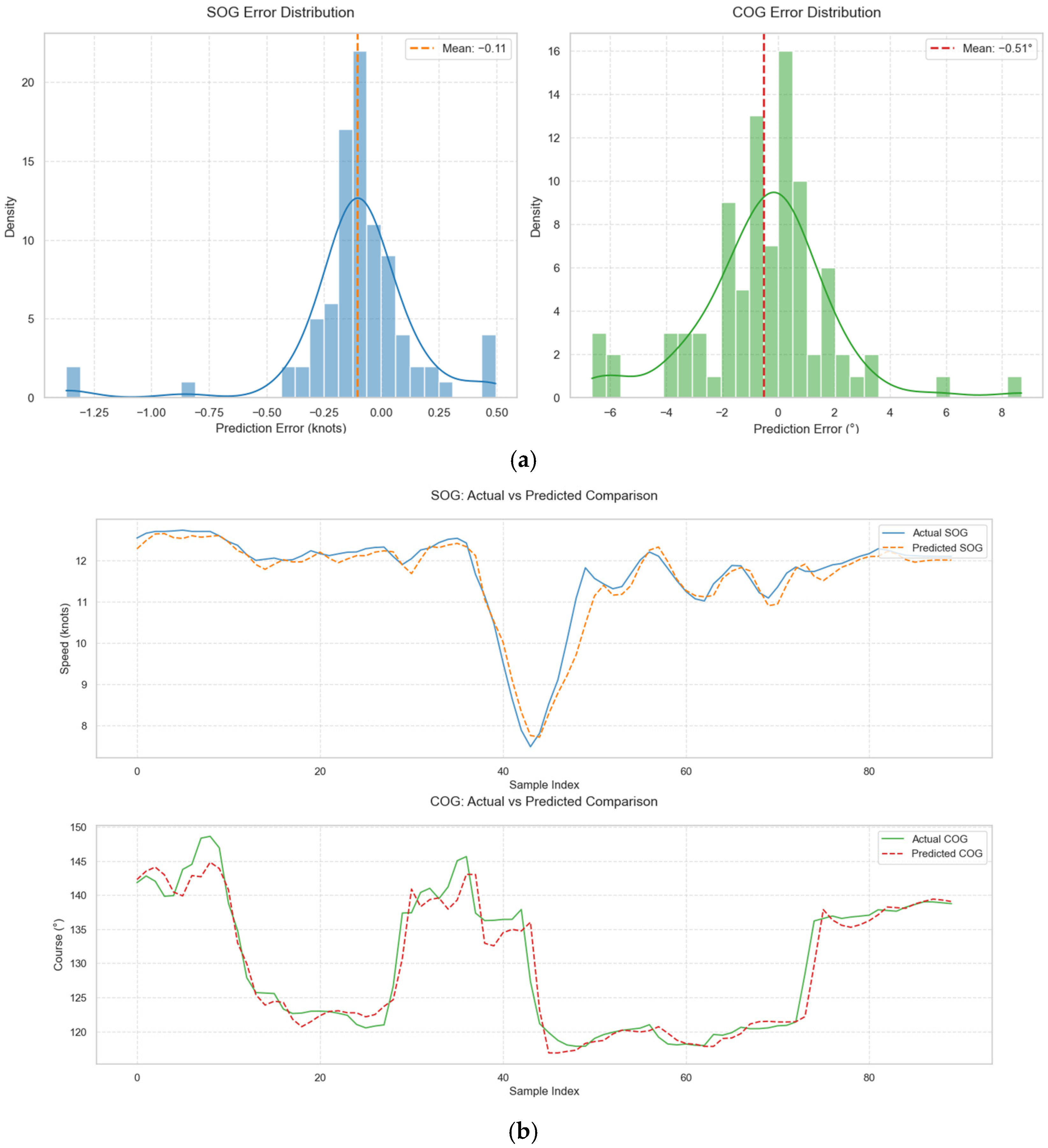


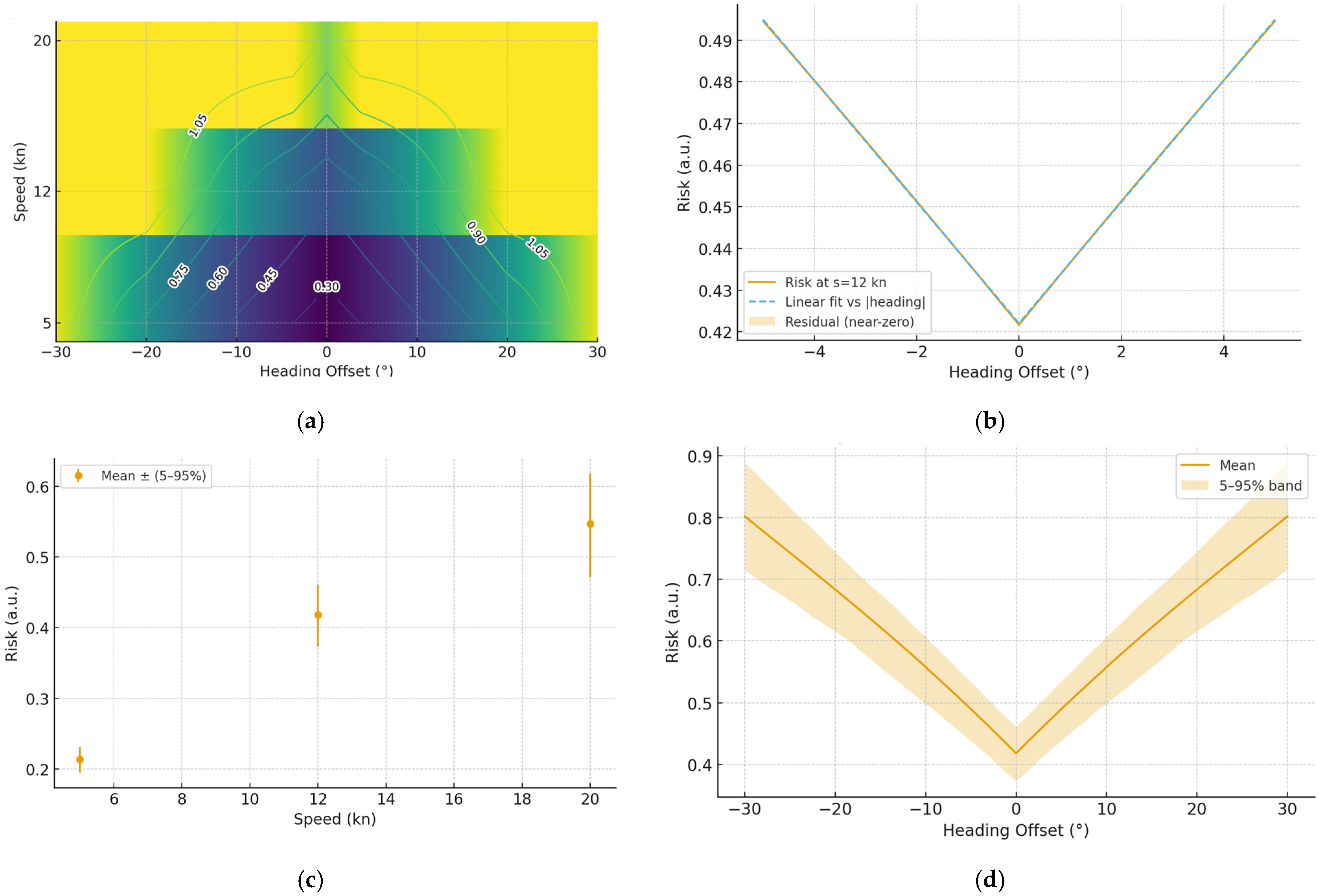


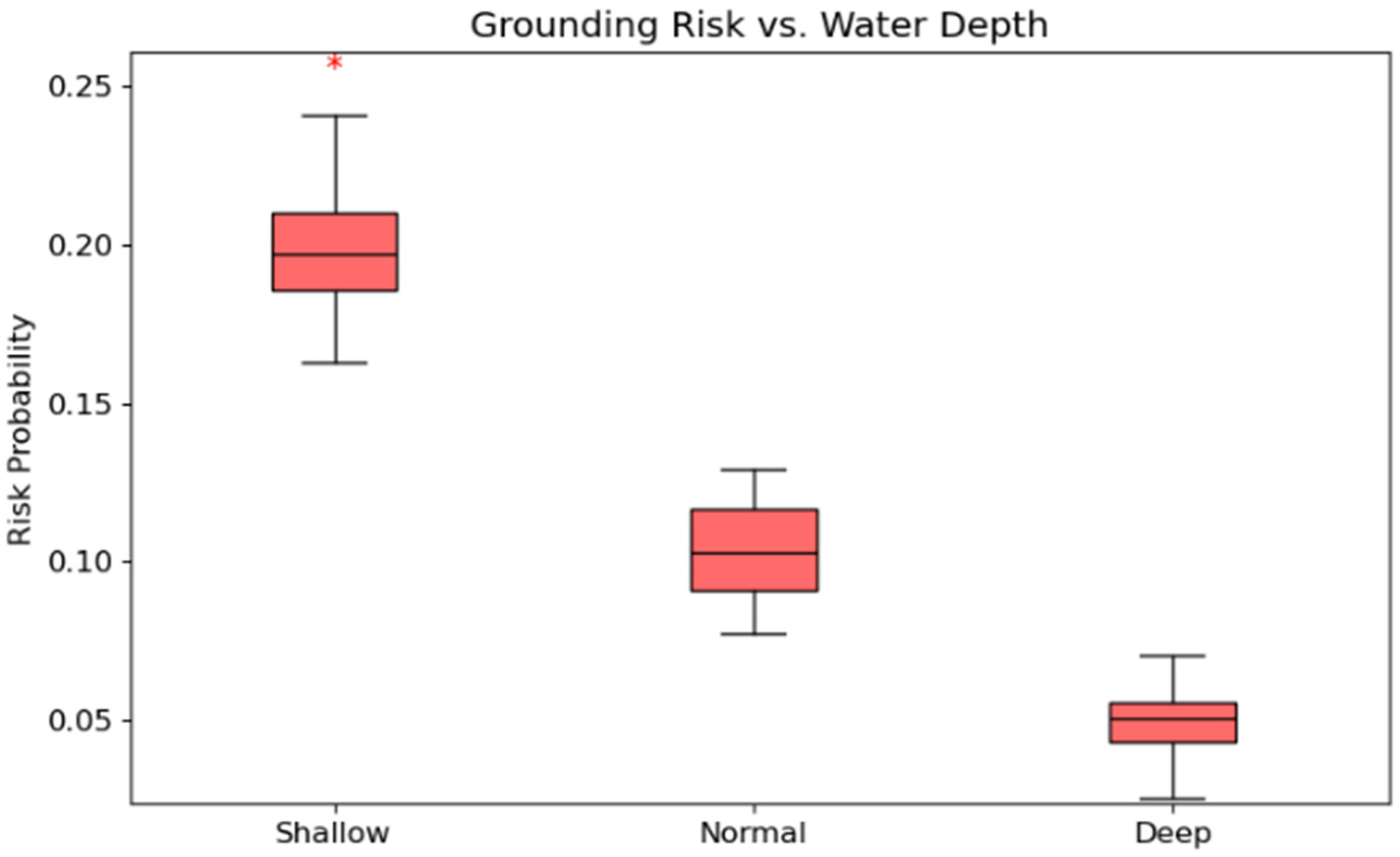


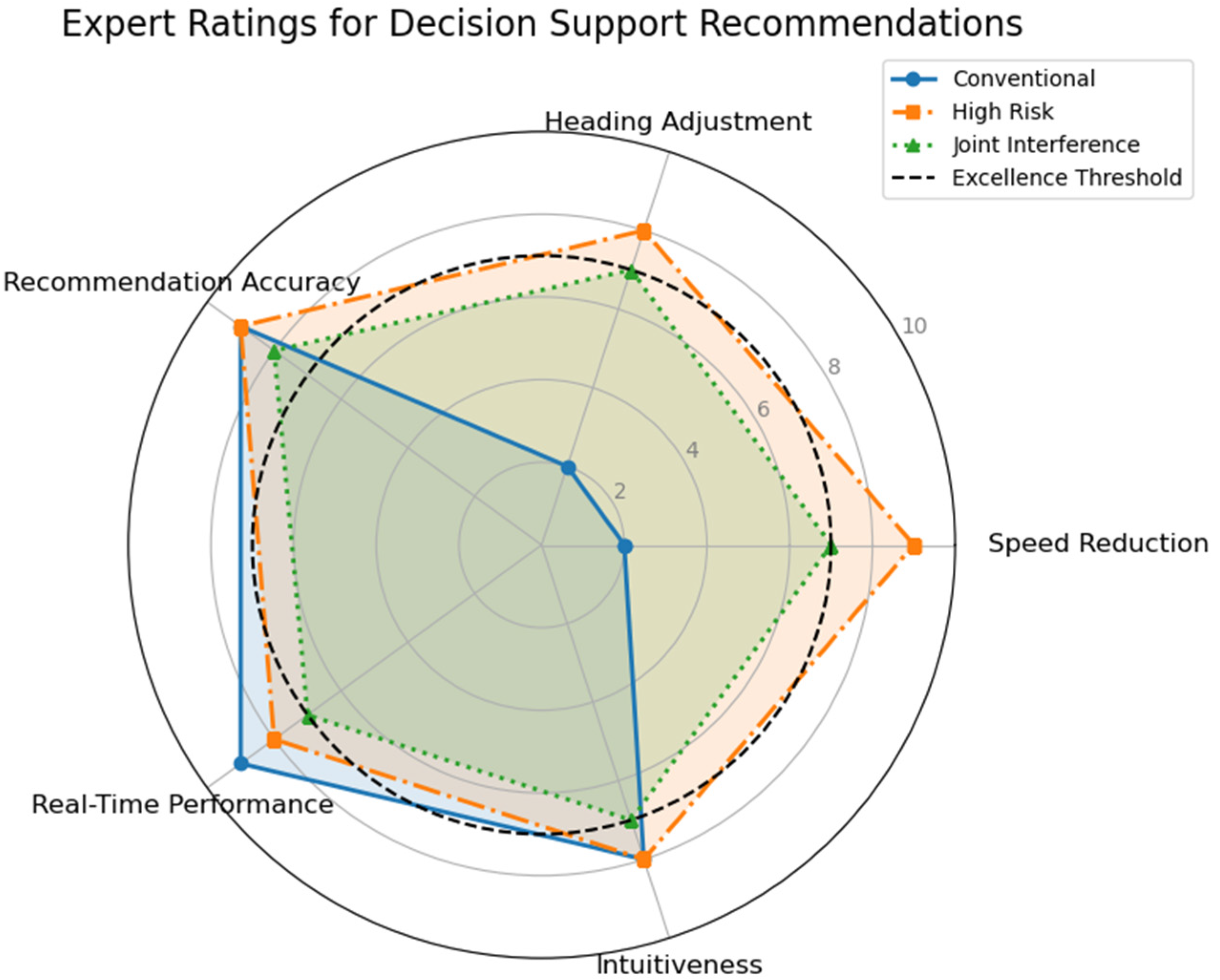




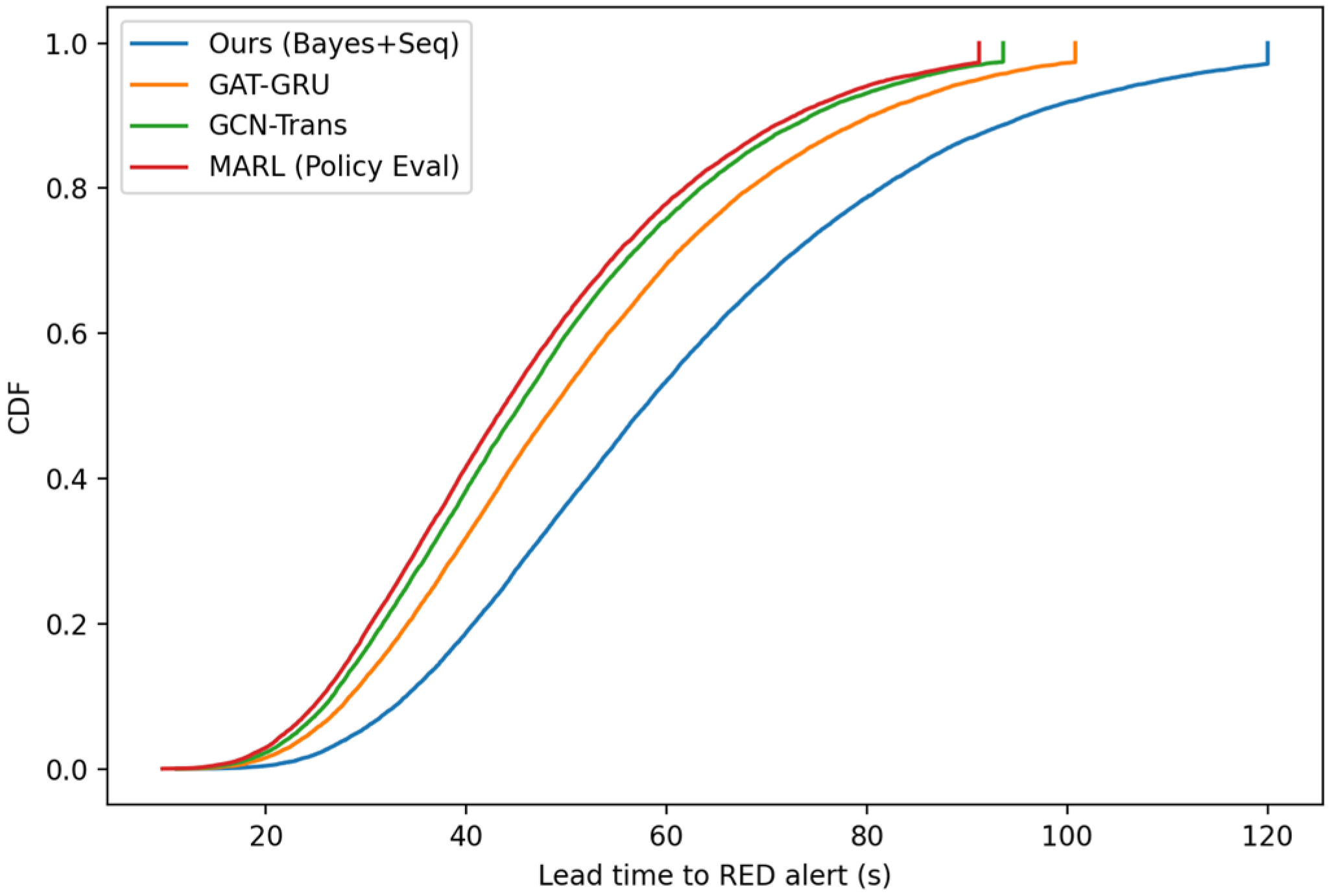
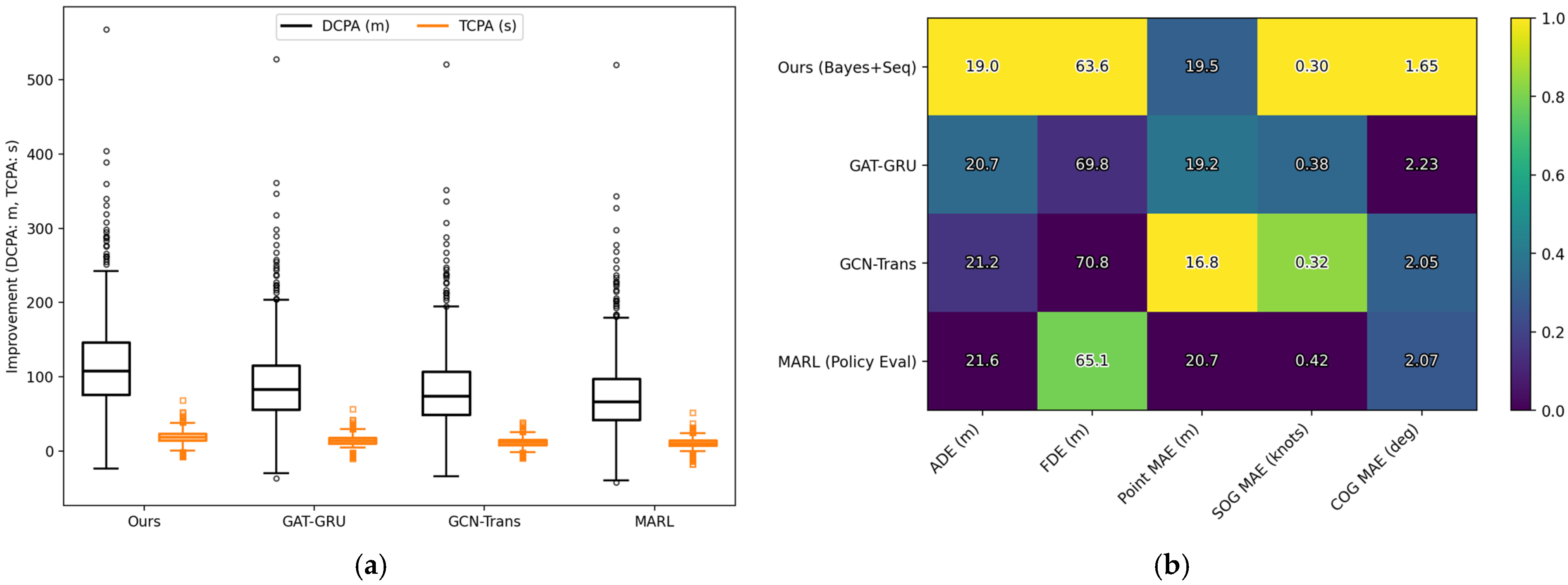
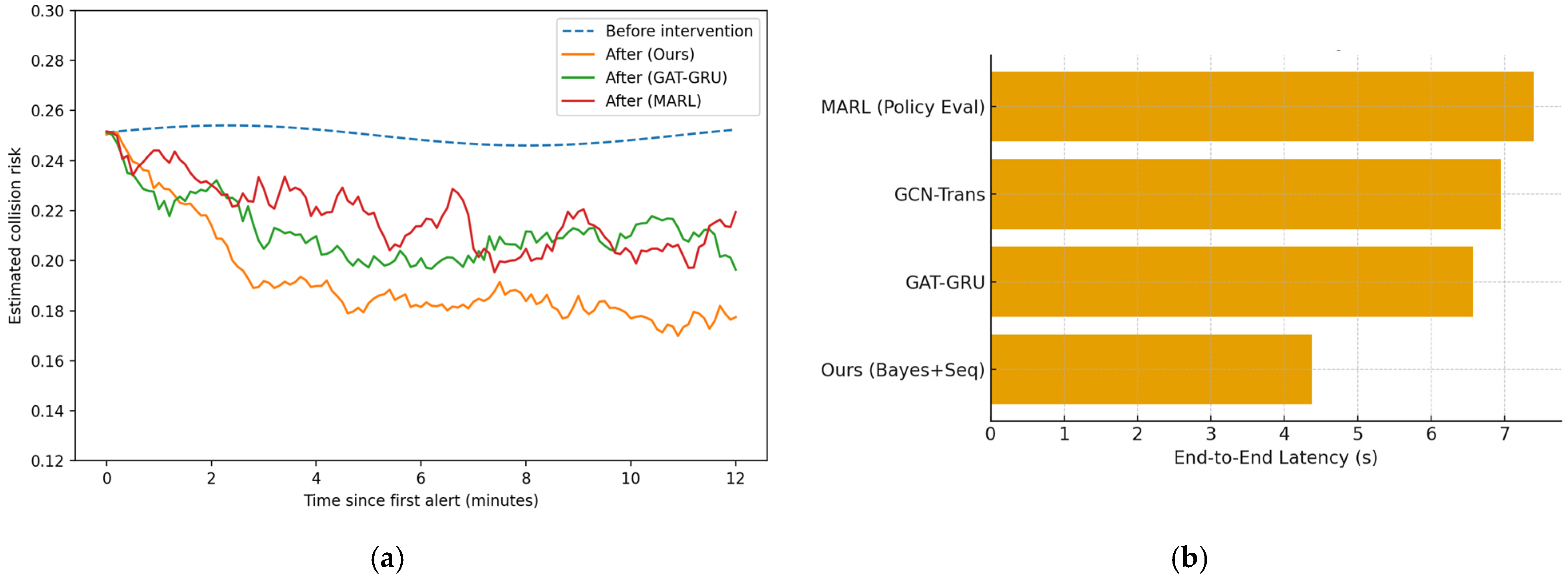
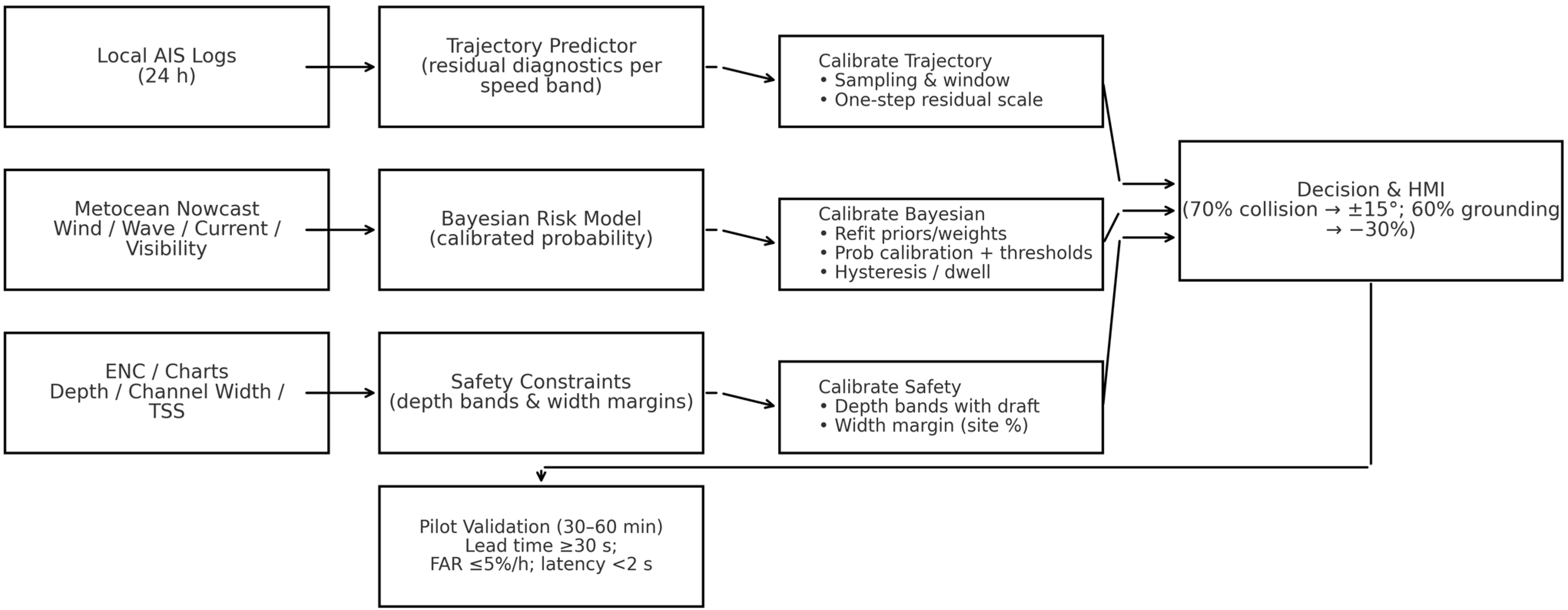

| Group | Typical Papers | Strengths | Limitations |
|---|---|---|---|
| LSTM/GRU sequence | [15,16,23,24] | “cascaded BiLSTM + BiGRU”; “ultra-short-term correction” | Data-shift sensitive; weak geo/rule |
| CNN × RNN hybrids | [18,19] | “spatio-temporal matrices + geography”; “CNN-LSTM for trajectory & collision” | Heavier; limited interpretability/uncertainty |
| Graph/Attention/Transformer | [17,20,31,33] | “ST-GRUA multi-ship interaction”; “G-STGAN gates”; “Transformer + clustering (regional risk)” | Complex; real-time/compute burden |
| Online correction/response | [24] | “ultra-short-term prediction; online correction” | Narrow scope; abrupt changes hard |
| Multi-task (traj + risk/intent) | [38] | “simultaneously predict trajectory & collision risk” | Costly labels; task trade-offs |
| Bayesian Networks | [25,26,29,35] | “DBN for imbalanced accidents”; | Needs curated data; structure learning hard |
| Regional/large-scale risk | [28,31] | “Transformer + clustering for regional risk”; “guided ML for safety” | Threshold/hyper Param sensitive; limited transfer |
| Ship-domain risk | [27] | “quaternion ship domain & VCRO; KDE viz” | Parametric assumptions; density-sensitive |
| Routing/ENC/triangulation | [32,37] | “ENC-based routing via Delaunay” | ENC updates lag; weak dynamics integration |
| MPC/control (GPU) | [40] | “GPU scenario-based MPC; uncertainty & obstacles” | Model/compute heavy; pruning needed |
| Complex networks (RBSCN) | [30] | “RBSCN with comprehensive centralities” | Graph/weights sensitive; topology-boundinterpretability tied to topology assumptions |
| Entity | Purpose | Essential Fields |
|---|---|---|
| areas | Bathymetry & administrative regions | geom (polygon), depth (m), region_id |
| line_features | Fairways/isobaths/boundaries | geom (line), type, name |
| symbols/light_symbols | Aids to navigation | geom (point), symbol_id, status, sector |
| tide_data | Hydrological context | station_id, timestamp, water_level |
| Category | Name | Source | Used for |
|---|---|---|---|
| Observed | Obstacle distance & relative bearing | ENC query around predicted waypoints | Collision risk |
| Observed | Excess water depth | Bathymetry along forecast path | Grounding risk |
| Observed | Weather (optional) | External feed | Modulating priors |
| Derived | Speed/Heading/Turn rate | Trajectory predictor (Section 3.3.1) | Conditioning CPTs |
| Output | P(collision∣E), P(grounding∣E) | Inference over small BN | Alerts/decisions |
| Output | Severity (coarse) | Fused from risks & context | Human–Machine Interface (HMI) priority |
| Risk Levels | Collision Probability Threshold | Stranding Probability Threshold | Corresponding Avoidance Actions |
|---|---|---|---|
| red | >70% | >60% | Autonomous Engine Shutdown with Navigational Advisory |
| yellow | 30–70% | 20–60% | Altering course |
| green | <30% | <20% | Maintain Situational Awareness Monitoring |
| Category | Threat | Mitigation | Evidence/Metric | Residual Risk |
|---|---|---|---|---|
| Data quality | AIS noise/missing/outliers | Time-series & spatial outlier filtering; resampling/interpolation | Clean set stable under 20–30% perturbation | Medium |
| Overfitting/selection bias | Training set shift vs. deployment | Temporal split, early stopping, dropout; leakage-free CV | Stable validation MAE; no leak detected | Low-Medium |
| Construct validity | Risk proxies/thresholds may misrepresent true risk | Ground rules from COLREG & expert input; ablation checks | Threshold audits documented | Medium |
| Geographic external validity | Model trained in Yangtze Estuary (Shanghai) | Transfer via small-scale calibration & stress tests | External tests pending | Medium |
| Ship-type external validity | Fast ferries, fishing boats, large tankers differ | Behavior clustering + type-specific tuning | Observed variability 5–12% | Medium |
| Temporal/seasonal effects | Seasonality/tide/weather under-modeled | Add seasonal/tidal features; expand data coverage | Planned extension | Medium |
| Infrastructure dependence | Sparse AIS or outdated ENC | Local cache, offline fallback, update checks | Degradation under poor coverage | Medium |
| Rare events | Few extreme near-miss/grounding cases | Minority-aware sampling + rule priors | Tail risk uncertainty acknowledged | Medium |
Disclaimer/Publisher’s Note: The statements, opinions and data contained in all publications are solely those of the individual author(s) and contributor(s) and not of MDPI and/or the editor(s). MDPI and/or the editor(s) disclaim responsibility for any injury to people or property resulting from any ideas, methods, instructions or products referred to in the content. |
© 2025 by the authors. Licensee MDPI, Basel, Switzerland. This article is an open access article distributed under the terms and conditions of the Creative Commons Attribution (CC BY) license (https://creativecommons.org/licenses/by/4.0/).
Share and Cite
Zhou, F.; Wang, S. A Hybrid Framework Integrating End-to-End Deep Learning with Bayesian Inference for Maritime Navigation Risk Prediction. J. Mar. Sci. Eng. 2025, 13, 1925. https://doi.org/10.3390/jmse13101925
Zhou F, Wang S. A Hybrid Framework Integrating End-to-End Deep Learning with Bayesian Inference for Maritime Navigation Risk Prediction. Journal of Marine Science and Engineering. 2025; 13(10):1925. https://doi.org/10.3390/jmse13101925
Chicago/Turabian StyleZhou, Fanyu, and Shengzheng Wang. 2025. "A Hybrid Framework Integrating End-to-End Deep Learning with Bayesian Inference for Maritime Navigation Risk Prediction" Journal of Marine Science and Engineering 13, no. 10: 1925. https://doi.org/10.3390/jmse13101925
APA StyleZhou, F., & Wang, S. (2025). A Hybrid Framework Integrating End-to-End Deep Learning with Bayesian Inference for Maritime Navigation Risk Prediction. Journal of Marine Science and Engineering, 13(10), 1925. https://doi.org/10.3390/jmse13101925





